Google Cloud offers several powerful tools for running containers, with Google Cloud Run and Google Kubernetes Engine (GKE) standing out as two of the most commonly used. While both services revolve around container deployment, they differ significantly in complexity, flexibility, and control. Choosing the right one depends on your workload, team expertise, and scalability requirements.
Google Cloud Run is a fully managed, serverless platform that allows you to deploy and run stateless containers without managing any infrastructure. It automatically handles scaling—down to zero when there's no traffic—and abstracts away networking, provisioning, and server management.
Developers simply provide a container image, and Cloud Run exposes it via an HTTPS endpoint. It’s particularly well-suited for APIs, event-driven services, or background processing jobs that need rapid scaling and low operational overhead.
Google Kubernetes Engine is a managed Kubernetes service that provides robust container orchestration. It gives teams full control over cluster configuration, networking, storage, and workload distribution. GKE is ideal for running complex microservices architectures or stateful applications where fine-grained control is necessary.
Unlike Cloud Run, GKE requires more effort to set up and maintain. However, it offers significant customization and supports a wide range of production-grade features like service meshes, custom controllers, and advanced autoscaling policies.
One of the main differences between Google Cloud Run vs GKE is the level of abstraction. Cloud Run handles the infrastructure for you—scaling, provisioning, networking, and load balancing are automatic. In contrast, GKE gives you the tools to do all of these things yourself using Kubernetes APIs and configurations.
Cloud Run is designed for simplicity and developer velocity. You focus on writing your code and packaging it in a container, while the platform handles the rest. It’s a great choice for fast-moving startups or teams that want to ship quickly without worrying about operational complexity.
GKE, on the other hand, is about flexibility and control. It allows you to run highly customized, interconnected workloads, including stateful services, batch jobs, and third-party tools like Prometheus or Istio. It’s a better choice for organizations with mature DevOps practices or those operating at enterprise scale.
Cloud Run offers automatic, per-request scaling, which means your service can go from zero to thousands of instances almost instantly, depending on demand. It’s built for stateless applications and performs especially well under spiky or unpredictable workloads.
GKE also supports autoscaling, but it’s based on metrics like CPU usage or custom resource definitions. It does not scale to zero by default, meaning you’ll always have a baseline cost even when traffic is low. However, GKE gives you more precise control over how and when scaling occurs, which can be important for fine-tuning performance and cost.
Cloud Run uses a pay-per-use model. You only pay for the CPU, memory, and request time consumed while your container is actively handling requests. This makes it highly cost-effective for applications with intermittent usage.
GKE’s cost model is based on the underlying compute instances that make up the Kubernetes cluster. Even if your pods aren’t doing anything, you still pay for the resources being provisioned. That said, with tools like GKE Autopilot or node autoscaling, you can reduce some of this overhead.
From a developer’s perspective, Cloud Run is much easier to get started with. There’s no need to understand Kubernetes internals or manage YAML configurations. You can deploy a service using just a Docker image and a few CLI commands.
GKE introduces more operational overhead. You’ll need to manage cluster updates, role-based access control, persistent storage, ingress rules, and more. However, for teams that need this kind of control, GKE’s capabilities are unmatched.
Choose Cloud Run if:
You're building lightweight APIs or microservices
You want minimal DevOps involvement
Your application is stateless and doesn’t need persistent storage
You prefer automatic scaling, including down to zero
You're looking to optimize cost for bursty or low-traffic workloads
Choose GKE if:
Your app has complex architecture with multiple interdependent services
You need to run stateful workloads or manage persistent volumes
Your team is familiar with Kubernetes or requires advanced orchestration
You want full control over networking, policies, and observability
Your infrastructure needs to support hybrid or multi-cloud deployments
While both Cloud Run and GKE are powerful in their own right, the best choice depends on your team’s needs and technical requirements. Cloud Run offers ease of use and cost-efficiency, making it perfect for small to medium workloads. GKE provides flexibility and robustness, essential for complex systems that require deep customization.
Some organizations even combine both: using Cloud Run for stateless frontends or lightweight services, and GKE for backends and core infrastructure. This hybrid approach leverages the strengths of both platforms and ensures maximum agility.
Would you like this adapted with a comparison of performance benchmarks or a walkthrough of a deployment example?
